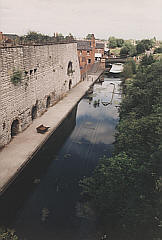
| Home | Research
Home |
![]()
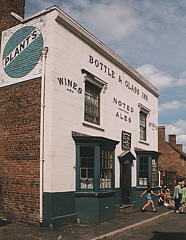
The Black Country Museum in Dudley is an open air museum ideally located
on a rich industrial site just below Dudley Castle. Two brief guides were
available, when I took these photographs, identical except for the captions
on the front fold, "Imagine a Day Spent in the Past!" or "Recreating the
heart of an industrial community".
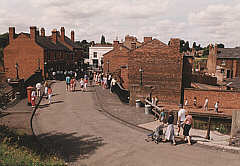 Established
for over 20 years the site is reaching a degree of maturity, although
continually developing. Uniquely the 26 acre site contains a well preserved
bank of lime kilns and has wharves on the local the canal network which
served the Earl of Dudley's lime pits by tunnel to nearby Wren's Nest,
as well as the local underground workings of Castle Hill. The canal is
on the north of the site, it was originally Lord Ward's Canal, and eventually
was extended via the Dudley tunnel to connect up with the Dudley (No1)
Canal south of Dudley. It provided lime to the Iron works leased from
the Dudley Estate, and other works around Pensnett, Netherton and Brierly
Hill, and Stourbridge, as well as connecting the northern areas of the
Black Country with the Stour Valley. The estate had a near monopoly in
supplying limestone to the blast furnaces in the region, controlled from
this lime works.
Established
for over 20 years the site is reaching a degree of maturity, although
continually developing. Uniquely the 26 acre site contains a well preserved
bank of lime kilns and has wharves on the local the canal network which
served the Earl of Dudley's lime pits by tunnel to nearby Wren's Nest,
as well as the local underground workings of Castle Hill. The canal is
on the north of the site, it was originally Lord Ward's Canal, and eventually
was extended via the Dudley tunnel to connect up with the Dudley (No1)
Canal south of Dudley. It provided lime to the Iron works leased from
the Dudley Estate, and other works around Pensnett, Netherton and Brierly
Hill, and Stourbridge, as well as connecting the northern areas of the
Black Country with the Stour Valley. The estate had a near monopoly in
supplying limestone to the blast furnaces in the region, controlled from
this lime works.

Site of the Black Country Museum 1901 1:2500 OS map
 Many
disused mine shafts from coal, ironstone and lime workings are known to
have existed on the site, and some are shown on the above map as well
as the remains of tramways, and rail links to the Earl of Dudley's Castle
Mill works, (top left). This workshop was the engineering works for the
whole estate, and undertook the construction and repair of steam engines,
locomotives, mining machinery, in fact all the equipment required by the
Dudley Estate. It had been built to replace its forerunner the "Level
Yard" which had become part of the Round Oak Iron Works. The timber yard
alongside the railway produced the pit-head gear and pit props etc. for
the collieries on the estate.
Many
disused mine shafts from coal, ironstone and lime workings are known to
have existed on the site, and some are shown on the above map as well
as the remains of tramways, and rail links to the Earl of Dudley's Castle
Mill works, (top left). This workshop was the engineering works for the
whole estate, and undertook the construction and repair of steam engines,
locomotives, mining machinery, in fact all the equipment required by the
Dudley Estate. It had been built to replace its forerunner the "Level
Yard" which had become part of the Round Oak Iron Works. The timber yard
alongside the railway produced the pit-head gear and pit props etc. for
the collieries on the estate.
These three works, Lime, Engineering & Timber, helped to make the estate self-sufficient and its tenants were often contracted to take estate coal, lime and other consumables for their Ironworks & Collieries. As a consequence the wharves on the site would have been in constant use.
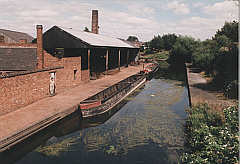 Around
the beginning of the 20th century the lime workings were becoming exhausted
and production had ceased at Wrens Nest by 1924, the Lime Works went into
disuse and were covered over and the majority of the museum site became
a sewage works.
Around
the beginning of the 20th century the lime workings were becoming exhausted
and production had ceased at Wrens Nest by 1924, the Lime Works went into
disuse and were covered over and the majority of the museum site became
a sewage works.
Close by other areas of land, particularly the "Worcestershire County Cricket Ground" were abandoned because of subsidence and are only now beginning to be re-used after years of work trying to stabilise and consolidate the ground, with millions of tons of concrete grouting being pumped into underground workings.
So the site for the Museum is particularly apt because of its past history, close proximity to the historic castle and the links with the Earl of Dudley,
The Museum tells us in its literature that it "creates a living tribute to the enterprise of the people of the Black Country". This is brought about in a number of ways. Primarily by the relocation of typical regional buildings and artifact, reconstructed in a way that purports to represent a cross section of the regions history, This has been carried out well except a Village would not have been sited between the canal and the canal arm to the lime kilns.
 A
second type of tribute to the past is the Castlefields Iron Co, Racecourse
Colliery and the Newcomen engine, and these need to work in a very different
way. The Iron works when working provides an invaluable insight 'into
the way people worked little changed for most of the 19th century and
into the early 20th century. The Colliery is more problematic, the pit-head
gear looks authentic in appearance, but its context is very false, the
mine entrance and tour fools only a few. For very little cost, but with
a lot more imagination a far more impressive mine tour could be devised.
The Newcomen engine has brought new insights into the early development
of the steam engine. By building a full-scale replica much valuable knowledge
has been acquired of the skills and techniques that were in use at the
beginning of the 18th century. The engine is a particularly apt feature
as it is a replica the original 1712 Newcomen Engine, which was located
at Lord Ward's Coneygree Coal Works less than 1/2 a mile away
A
second type of tribute to the past is the Castlefields Iron Co, Racecourse
Colliery and the Newcomen engine, and these need to work in a very different
way. The Iron works when working provides an invaluable insight 'into
the way people worked little changed for most of the 19th century and
into the early 20th century. The Colliery is more problematic, the pit-head
gear looks authentic in appearance, but its context is very false, the
mine entrance and tour fools only a few. For very little cost, but with
a lot more imagination a far more impressive mine tour could be devised.
The Newcomen engine has brought new insights into the early development
of the steam engine. By building a full-scale replica much valuable knowledge
has been acquired of the skills and techniques that were in use at the
beginning of the 18th century. The engine is a particularly apt feature
as it is a replica the original 1712 Newcomen Engine, which was located
at Lord Ward's Coneygree Coal Works less than 1/2 a mile away
Finally to bring the whole village to life period costumed staff re-enact a lifestyle of the past, unfortunately what cannot be shown, due to staffing levels, is the true number of people who would have been working and living in these buildings.
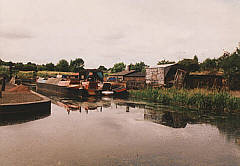 The
Museum uses the famous quotation from Elihu Burritt "The Black Country,
black by day, and red by night, cannot be matched for vast and varied
production by any other space of equal radius on the surface of the globe".
However more importantly in the same book "Walks in the Black Country
and its Green Borderland" Burritt gives us important descriptions of the
working conditions in the region, particularly the families of nail makers,
often the husband working as a collier, the wife and daughters making
hand made nails, four to a hearth, or the women in the brickyards with
teenage and younger girls fetching the raw materials and taking the formed
brick to the drying floors. None of this is shown but perhaps a brickyard
could be reconstructed and children (or adults) could make hand-made bricks
with help and supervision. Brick making was always a major industry in
the Black Country and continues today. Unfortunately the "Health &
Safety Executive" would probably veto children trying their hand at making
hand-made nails, or chain making.
The
Museum uses the famous quotation from Elihu Burritt "The Black Country,
black by day, and red by night, cannot be matched for vast and varied
production by any other space of equal radius on the surface of the globe".
However more importantly in the same book "Walks in the Black Country
and its Green Borderland" Burritt gives us important descriptions of the
working conditions in the region, particularly the families of nail makers,
often the husband working as a collier, the wife and daughters making
hand made nails, four to a hearth, or the women in the brickyards with
teenage and younger girls fetching the raw materials and taking the formed
brick to the drying floors. None of this is shown but perhaps a brickyard
could be reconstructed and children (or adults) could make hand-made bricks
with help and supervision. Brick making was always a major industry in
the Black Country and continues today. Unfortunately the "Health &
Safety Executive" would probably veto children trying their hand at making
hand-made nails, or chain making.
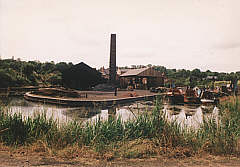 The
Black Country Museum is on one site and comparisons can be made with Blists
Hill, However Blists Hill is part of a group of Museums, which together
provide a far greater understanding of early industry, & the Ironbridge
Gorge and its surroundings. In comparison the Black Country Museum should
be providing a far broader overview of the Black Country in a number of
ways.
The
Black Country Museum is on one site and comparisons can be made with Blists
Hill, However Blists Hill is part of a group of Museums, which together
provide a far greater understanding of early industry, & the Ironbridge
Gorge and its surroundings. In comparison the Black Country Museum should
be providing a far broader overview of the Black Country in a number of
ways.
First by the reconstruction and restoration projects - these it has undertaken well, except perhaps the village should not have been located between the canal and the former lime works arm of Lord Ward's canal. This is a an extremely unlikely setting for a village, if it had been built surrounding "Racecourse Colliery" that would have been an extremely authentic representation of the region. Blists Hill is far better laid out.
Secondly by providing an overview of the historical development of the area, this is handled extremely poorly, and the resources and research required would only require a small budget.
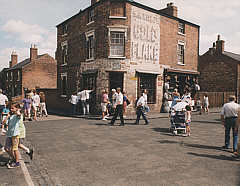 Thirdly
by relating the museum to the existing landscape of the region. Apart
from a very small offshoot of the museum, the Mushroom Green Chain makers
shop, which is only open one Sunday each month over the summer, nothing
else is put forward by the Museum. However the local authority, Dudley
Metropolitan Borough, has provided money to improve attractions and facilities,
particularly by opening up the canal tunnels to a greater number of visitors
by funding the construction of a gyratory relief route. In addition they
are marketing the Museum as part of a package of attractions in Dudley,
along with the Castle and Zoo, under the title of "Black Country World".
Thirdly
by relating the museum to the existing landscape of the region. Apart
from a very small offshoot of the museum, the Mushroom Green Chain makers
shop, which is only open one Sunday each month over the summer, nothing
else is put forward by the Museum. However the local authority, Dudley
Metropolitan Borough, has provided money to improve attractions and facilities,
particularly by opening up the canal tunnels to a greater number of visitors
by funding the construction of a gyratory relief route. In addition they
are marketing the Museum as part of a package of attractions in Dudley,
along with the Castle and Zoo, under the title of "Black Country World".
The Museum is fulfilling its stated function of portraying the past, but primarily by operating as a theme park, rather than a museum continuing to develop a greater and evolving understanding of the region. As such it is mainly seen as popular entertainment as opposed to being historically accurate, although fortunately not as inaccurately as the Model T Ford or the Victorian "Digital photographic studio" currently to be found at the Victorian Village at Blists Hill.
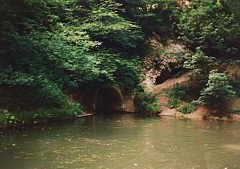 The
logical development would be to evolve a way of showing a far broader
overview of the industrial and social development of the region, from
the early industrialisation of the region in the 17th century to the present
day. This would provide additional exhibits and displays to complement
what already exist at the museum site. But perhaps more importantly the
museum should make an effort to forge links with the community, and also
encourage its visitors to visit others sites in the Black Country.
The
logical development would be to evolve a way of showing a far broader
overview of the industrial and social development of the region, from
the early industrialisation of the region in the 17th century to the present
day. This would provide additional exhibits and displays to complement
what already exist at the museum site. But perhaps more importantly the
museum should make an effort to forge links with the community, and also
encourage its visitors to visit others sites in the Black Country.
Only two miles away a new visitor's centre at Bumble Hole has just opened, manned by local volunteers, and operating on minimal funds, The museum could forge links with this centre at almost no cost, to the mutual benefit of both. Canal boat trips could be run from the museum through either the Dudley or Netherton tunnels to visit the centre and interpret the landscape South of Dudley, and many people would have an extremely enjoyable day out, while making money for the museum. But this should be the first of many new links with the community,
To conclude the Museum needs to radically rethink its purpose and direction, be far more accessible at different levels and become a true Museum and archive of the region.
These are my own personal views of a museum, which I feel lost its way a few years ago.
However more recently the Museum has begun a new program
of construction based around the rebuilding of Smethwich Rolfe Street
Baths at the site, this will provide new facilities which may well address
many of my criticism. (2000).
